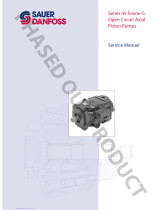
General Description
Series 90 Family of Pumps and Motors.....................................................................................................................................5
PLUS+1 Compliant Controls and Sensors................................................................................................................................5
Design...................................................................................................................................................................................................6
Series 90 Pictorial Circuit Diagram............................................................................................................................................. 7
System schematic.............................................................................................................................................................................7
Technical Specifications
General Specifications.................................................................................................................................................................... 8
Features and Options......................................................................................................................................................................8
Operating Parameters.....................................................................................................................................................................9
Fluid Specification............................................................................................................................................................................9
Operating Parameters
Input Speed......................................................................................................................................................................................10
Independent Braking System...............................................................................................................................................10
System Pressure..............................................................................................................................................................................10
Servo Pressure.................................................................................................................................................................................12
Charge Pressure..............................................................................................................................................................................12
Charge Pump Inlet Pressure.......................................................................................................................................................12
Case Pressure...................................................................................................................................................................................12
External Shaft Seal Pressure.......................................................................................................................................................13
Temperature....................................................................................................................................................................................13
Viscosity.............................................................................................................................................................................................13
System Design Parameters
Filtration System.............................................................................................................................................................................14
Filtration Options...........................................................................................................................................................................14
Suction filtration – Option S................................................................................................................................................. 14
Charge pressure filtration (partial charge pump flow)............................................................................................... 15
Remote charge pressure filtration......................................................................................................................................15
Fluid Selection.................................................................................................................................................................................15
Reservoir............................................................................................................................................................................................15
Case Drain.........................................................................................................................................................................................16
Pump Life..........................................................................................................................................................................................16
Charge Pump...................................................................................................................................................................................16
Charge pump sizing/selection.............................................................................................................................................16
Bearing Loads and Life.................................................................................................................................................................17
Applications with external shaft loads..............................................................................................................................17
Understanding and Minimizing System Noise....................................................................................................................18
Sizing Equations.............................................................................................................................................................................18
Mounting Flange Loads...............................................................................................................................................................18
Master Model Code
Series 90 Master Model Code Breakdown............................................................................................................................ 21
S90 Rotation and Size Options..................................................................................................................................................21
Control Options..............................................................................................................................................................................22
Pressure, Aux Mounting, Ports, Filtration, Displacement Limitation Options......................................................... 23
Shaft and Charging System........................................................................................................................................................24
Control Orifice Options................................................................................................................................................................25
Special Hardware and Pressure Settings...............................................................................................................................26
Control Features
3-Position (FNR) Electric Control - DC, DD............................................................................................................................ 27
Response time........................................................................................................................................................................... 28
Electric Displacement Control (EDC), Options KA, KP, KT................................................................................................28
Features and Benefits..............................................................................................................................................................28
Response time........................................................................................................................................................................... 31
Pump output flow direction vs. control current............................................................................................................32
Manual Over Ride (MOR).............................................................................................................................................................32
Hydraulic Displacement Control (HDC), Option HF...........................................................................................................33
Technical Information
Series 90 Axial Piston Pumps
Contents
©
Danfoss | March 2020 BC152886483413en-000907 | 3






















